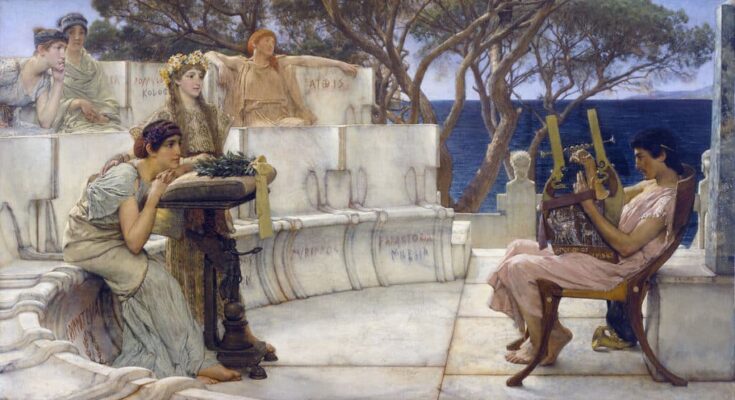
Rap has been popular in music since the late 1970s. However, the concept predates the contemporary genre by thousands of years. Rhapsodies in ancient Greece were a form of rhythmic storytelling.
Like rap, ancient performers used rhythm, memorization, and improvisation.
Oral storytelling in rhapsodies and rap
Rhapsody in ancient Greece was an art form based on the spoken word. Like rappers today, rhapsodes delivered their verses with rhythm and flow. They memorized long, complex passages, much like modern rappers memorize lyrics.
The goal of both ancient Greek rhapsodies and rap is to entertain audiences through storytelling. Rhapsodes told grand tales from works like Homer’s Iliad and Odyssey, passing down cultural values through their performances.
Imagine the work it would take for these performers to memorize 15,693 lines just for one performance of the Iliad.
Similarly, rap serves as social commentary, with rappers telling stories about their lives, communities, and struggles. However, rap and rhapsodies aren’t just words, as that would be a mere speech. These are musical expressions, after all.
Rhythm and rhyme
Both ancient Greek rhapsodies and modern rap rely on rhythm. Rhapsodies consist of epic lines chanted or sung accompanied by a beat. Eight different poetic meters determined the rhythm at which a poem would be performed.
The most popular was the Dactylic Hexameter, which consists of six metrical feet per line. This meter was used for epic poetry, most famously in works like Homer’s Iliad and Odyssey and Hesiod’s Theogony.
For instance, Homer’s Iliad opens with a line in dactylic hexameter: “Sing, O goddess, the anger of Achilles, son of Peleus.”
Rap, of course, is built entirely around rhythm. The flow in rap refers to how a rapper’s words interact with the beat. The performer’s timing and rhythm create momentum, much like the rhythm in rhapsody-guided epic storytelling.
In both traditions, rhythmic delivery connects the words to the listener, giving the performer’s voice its power.
Public performance builds energy in rhapsodies and rap
Rhapsodes were public performers who appeared at festivals or public gatherings to recite their stories. Their vocal delivery was designed to captivate and entertain the audience.
Ancient Greeks viewed this performance style as an essential cultural practice. City-states commonly employed rhapsodes to perform at public festivals, such as religious ones. Likewise, wealthy patrons like aristocrats hired rhapsodes for private symposia.
Likewise, rap began in public spaces, with early rappers performing at parties or on street corners. Modern rap still thrives on live performance. The energy and exchange between the rapper and the audience are critical. Much like rhapsodes, rappers control their delivery to command attention and keep their listeners engaged.
Improvisation reveals the artist’s skill
Although ancient Greek rhapsodes memorized a set text, they also improvised. Depending on the audience or context, they varied their recitation. This adaptability allowed rhapsodes to express individuality.
This improvisation may be why there are so many variations of myths around the ancient Greek world. Each place wanted to highlight the aspect of the story most relevant to them.
For instance, Heracles was often portrayed more abstractly in Athens as a cultural hero who protected the city and its values. In contrast, in Thebes, the hero’s supposed birthplace, the city was brought to the fore.
Rhapsodes would tailor their recitations to suit these regional perspectives, highlighting the elements that resonated most with their specific audience.
In rap, improvisation is an art in itself. Freestyling, or creating verses on the spot, is a core part of the rap tradition. It allows rappers to showcase creativity, quick thinking, and unique voice. While the specifics differ, improvisation connects the two traditions.
Both rap and ancient Greek rhapsodies value this element of spontaneous creativity, which allows performers to put their personal stamp on each performance. Like improvisation, rap and rhapsody content also bears a resemblance.
Narrative content reflects cultural values in rhapsodies and rap
The content of ancient Greek rhapsodies often focused on epic tales of heroism, war, and the human condition. Stories from Homeric poems were meant to inspire and reflect the values of Greek society. These narratives served to entertain and educate the public.
Epic tales were central to paideia, Greek education. The Iliad was instrumental in guiding how a young Greek boy should behave. Even at the end of Alexander the Great’s campaign, he purportedly slept with a copy underneath his pillow.
Rap lyrics often serve a similar purpose, though the topics are different. Rappers frequently address personal experiences, social injustice, and societal struggles. Through their narratives, they provide insight into the lives and experiences of marginalized communities.
Rap is popular with young adults, who often consider rappers role models. Their morals and perspectives on life impact popular culture, for instance, through fashion. Both art forms rely on storytelling to deliver cultural commentary that impacts or has impacted their societies—particularly the younger generations.
Is rap really a modern innovation?
Though rap’s themes and context are new, at its creative core, it is a continuation of an older tradition. Ancient Greek rhapsodies were a form of rap enjoyed by ancient audiences. Like its modern counterpart, it relied on rhythm, oral tradition, and improvisation.
The art of rhythmic recitation of stories throughout history indicates how engaging this art form is. Fundamentally, this storytelling medium may be popular because it activates multiple senses. The approach ensures the listener stays immersed in the story, hanging on the performer’s every word.



